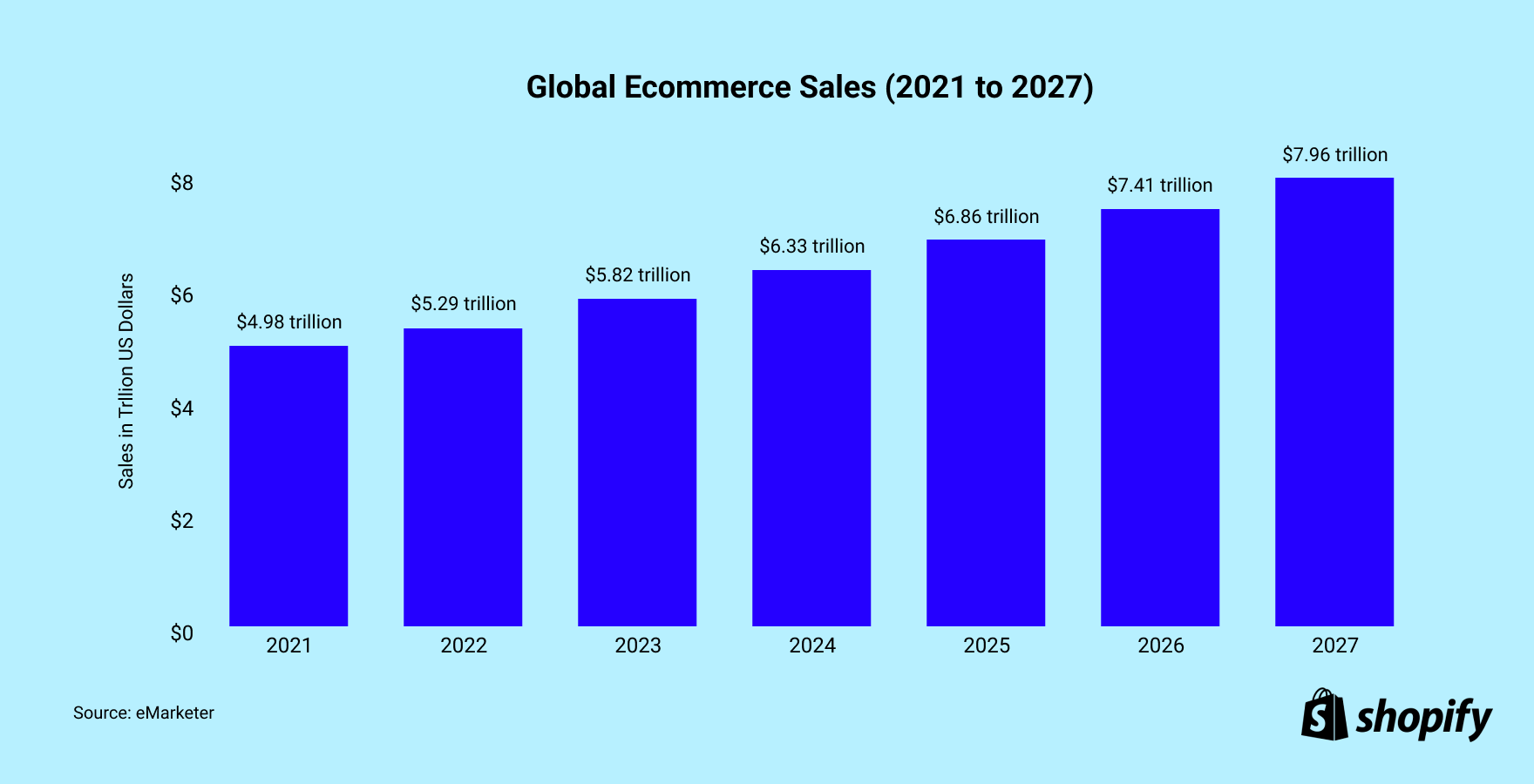Implementing a sales channel strategy has become a requirement for every business. The strongest brands use multiple sales channels to meet customers where they already spend their time.
By providing convenient ways for customers to shop, you can increase your ecommerce business’s reach and brand recognition. Spreading your business across platforms also boosts resiliency, as you become less dependent on a single channel or market.
Here, learn about the different types of sales channels used by online businesses—and how you can leverage them.
What is a sales channel?
A sales channel is a pathway that businesses use to reach customers and sell their products. Online marketplaces, retail stores, and social media accounts are all potential sales channels. Sales channels can be used to find and target different customer audiences, so most businesses consider multichannel selling a good idea.
Direct sales channels
Your business works directly with consumers under a direct sales channel strategy. For example, Apple sells its products through its own stores and website.
Indirect sales channels
Indirect sales channels use third parties, like distributors and retailers, to sell products to consumers. Olipop, for instance, sells its healthy soda pop through Whole Foods. Indirect sales channels can also include marketplaces like Amazon, eBay, and Alibaba.
Distribution channels
Distribution channels are how products move from the manufacturer to the consumer. Many companies use third-parties like dropshipping, print on demand, or 3PLs to manage fulfillment and keep costs low.
The 10 most important sales channels
- Online store (direct to consumer)
- Modern marketplaces
- Traditional marketplaces
- Retail
- Wholesale
- Resellers
- White label
- Mobile apps
- B2B sales
- Partnerships
1. Online store (direct to consumer)
An online store is the first sales channel many new entrepreneurs create—and for good reason.
When you design your own store, you get to decide how products are displayed. You also get a complete view of customer data and sell directly to consumers (DTC), meaning you keep all the profits.
That direct relationship can be beneficial for your brand. Research shows that DTC ecommerce is growing across locations and industries, with most customers preferring to buy from independent stores over multi-brand retailers.
With Shopify, you can set up multiple sales channels and direct those customers back to your store.
Pros:
- Low startup costs. Build a store for free with Shopify’s free trial
- Use your store as a sales channel hub
- Use customer data to improve sales lead generation
- No third-party branding or product rules
- Take all the profits from your sales
Cons:
- Generating traffic can be difficult without a large marketing budget
- It’s up to you to manage orders (Shopify can help)
💡 Scroll down this post to find out how to set up sales channels from your Shopify store.
2. Modern marketplaces
Modern marketplaces are content-driven platforms that enable commerce. This includes social media channels like Instagram, TikTok, Facebook, and Pinterest. Increasingly, it also covers streaming sites like Spotify.
One of the reasons modern marketplaces are so successful as online sales channels is that buyers are already spending time there. Customers see products immediately, in a context they’re familiar with. Adding a Buy button to a social media post is often a natural next step.
On Instagram, for example, you can make posts and Stories shoppable. If a customer sees an item they like, all they need to do is tap the shopping bag symbol and they’ll be directed to a page where they can see more details, visit your store, and check out.
Spotify, the music streaming service, is another modern marketplace built for selling. Listeners can scroll a band’s profile to preorder albums or purchase vinyl records and merch.

Data suggests customers increasingly prefer to make purchases on social media platforms. In 2023, global social commerce revenues were estimated at $570 billion and could reach $1.1 trillion by 2028.
Pros:
- Apps can help you track performance and optimize your posts
- You can collaborate with other brands and influencers to cross-sell and cross-promote
- Most social media platforms have useful templates for ads and post creation
Cons:
- Continuous content creation is required to stay visible
- It can be difficult to create content that caters to social media algorithms
💡 You can sell on Facebook and Instagram from your Shopify store.

3. Traditional marketplaces
Amazon, Etsy, eBay, and Google Shopping are examples of traditional marketplaces. These channels feature a wide range of product offerings, and customers generally search by the product they’d like to buy rather than the brand they’d like to purchase it from.
While traditional marketplaces come with a preexisting customer base, these platforms require you to give up control of customer service and fulfillment, and force competition on margins.
Pros:
- Put your products in front of a large existing customer base
- Use established distributors and marketing channels
Cons:
- Pay commission on sales made within traditional marketplaces
- Strict terms and conditions for brand and product promotion
- Fierce competition, including from international sellers with lower prices
4. Retail
The retail sales channel includes both permanent and pop-up shops, like a short-term rental in a mall, a booth at a craft fair, or a stall at a local market. Retail channels provide the opportunity to build relationships with your customers in-person and get live feedback. Retail is a powerful piece in the modern commerce playbook.
Pros:
- Face-to-face contact with customers
- Direct-to-customer sales
Cons:
- Many added costs and a potential need for employees
- Expensive brick-and-mortar overheads
5. Wholesale
Wholesale involves selling your products to other businesses who then retail them. Some businesses choose to make wholesale their only sales channel, others use wholesaling as one arm of an omnichannel sales strategy.
Pros:
- Move lots of inventory at once
- Retailers engage in marketing and sales for your products
Cons:
- Capital inventory funding required
- It can be expensive to store inventory that doesn’t sell
- No interaction with your customers
6. Resellers
A reseller is anyone who increases the value of a product and sells it for a higher margin. Adding value to a product can mean affiliation with an established retailer, repackaging it, or even improving the product itself.
Pros:
- Low overheads
- Upselling opportunities
Cons:
- Fluctuating price and availability depending on the items you’re reselling
- Inconsistent margins
- Required compliance with the original manufacturer’s reselling terms

7. White label
White-label products are generic products that can be customized with a brand’s logo or name. An example of this is the branded reusable bags that grocery stores sell at checkout counters. Trader Joe’s doesn’t manufacture its bags themselves, it simply buys generic ones and has its name printed on them.
Pros:
- Reduced cost of production
- Ability to jump on trends, like the stainless steel water bottle trend
- Market-tested products
Cons:
- Lots of competition
- Prices dependent on the suppliers’ prices for pre-printed items
💡 Learn more about the benefits of white-label businesses.
8. Mobile apps
By 2025, mobile commerce sales are expected to make up more than 10% of all retail sales in the US.
With consumers turning to apps to do their shopping, brands are responding by building out more capable apps. Brands offer filterable catalogs, gamified experiences, coupons, and special deals to people who download and shop through their apps.
Pros:
- Users spend longer on apps than on websites
- Use your app to deliver special offers
Cons:
- Apps can be expensive to build
- Apps require constant updating as technology advances

9. B2B Sales
Business-to-business sales are when one business sells products or services to another.
Pros:
- Companies have more spending power than consumers
- Once you develop a good relationship with a company or business, you’ll have a repeat customer
- Sales agents can leverage their networks and expertise to find clients and close deals
Cons:
- Companies can take a long time to make a purchase
- Possible higher costs to create products or services for businesses
10. Partnerships
A sales channel partnership is when you employ a company or individual to act as an extension of your sales team. For example, when a company uses social media influencers to promote their products through influencer marketing, that is a sales channel partnership. The influencer gets a discount on those products or a commission of all the sales their posts generate, and the company gets the benefit of the influencer’s reach and audience trust.
Pros:
- Built-in consumer trust
- Reach new customers
- Save on marketing campaign costs
Cons:
- Your partners can misrepresent you
- You won’t get as much customer data as direct sales
- You may have to sacrifice some of your own profits to make the relationship profitable for your partners
Related article
Global Ecommerce Sales Growth Report
Global ecommerce sales are forecast to hit $6.3 trillion in 2024. Here are some numbers that tell the story of ecommerce sales worldwide.
Examples of brands using multiple sales channels
These sales channels each provide valuable ways to access customers. But if you only use a single channel, your business is limited by that channel’s reach and growth.
Harness several channels and you can distribute your resources to whichever channel is performing the best. Here are some examples of how Shopify merchants benefit from multichannel selling.
The Poster List—Ecommerce, retail, wholesale
Adam Luedicke, owner and founder of Long Beach poster store The Poster List, uses wholesale, in-person shows, and online sales as the main three channels for his business.
Since starting the business in 2006, Adam found that some channels boom while others dip, often in response to unpredictable external factors like interest rate hikes and the COVID-19 pandemic.

“Starting out, shows were definitely the majority of where the money was coming from, and then, 2010 through 2015, it flipped and it became more wholesale,” says Adam. “In 2017, the apparel space got soft at retail, and so we started doing shows again.”
By building out multiple sales channels, The Poster List was able to adapt quickly to the changes happening in the larger market. Meeting your customers at the channels relevant to your brand helps you build a more resilient business.
Abracadana—Marketplaces, ecommerce
Mary Helt is co-founder and owner of Abracadana, a store that sells screen-printed bandanas.
“It’s good to have a couple of venues for selling,” she says. “Sometimes I feel like one is pulling me—like Etsy is pulling me away from Shopify. Or if I’m working on updating Shopify, I’m not paying attention to Etsy. And I think that’s OK. You can cycle it. But try a couple of channels to see what works. You can’t have all of your eggs in one basket, that’s for sure.”

How to build a multichannel sales strategy
Your sales channels should work together and support your core product line.
For example, you might do the bulk of your business on your ecommerce website but then run flash sales on excess inventory via Instagram Stories.
When you started your business, you likely prioritized a single sales channel. Scaling by exploring new sales avenues can seem daunting—but it’s rarely as difficult as store owners think.
Here are five tips for managing multichannel selling:
1. Prioritize your channels based on profitability
Effective multichannel selling is about pinpointing the right channels for your business. To do this, think about:
- Where your target audience spends their time
- Which channels will have the lowest running costs
- Where your competitors are active
For example, selling your products on a traditional marketplace like Amazon, Etsy, or eBay might be the best next step for your ecommerce business.
Once you see profitability through one sales channel, you can then prioritize other channels accordingly, moving to each new channel as you see success on the previous channel.
💡 Read the Shopify guides for tips on how to sell on Etsy and how to sell on eBay.
2. Create a different strategy for each sales channel
Each sales channel you add to your business will require a different strategy for success. For example, you’d take a different approach to sending customers to your online store than you would creating foot traffic in a brick-and-mortar retail shop.
Furthermore, you’ll need to tweak your product descriptions and marketing messaging on different sites. Your Shopify site might tout how quickly products ship, but Amazon shoppers are used to the speed, so you’ll need to find a different way to entice customers to make a purchase.
3. Manage inventory and fulfillment
As you expand to different sales channels, you need to have the proper processes in place for inventory management and order fulfillment. Increasing the number of ways you can make sales will—hopefully—increase your total number of sales. And you need to have the inventory to accommodate that increase.
More than that, you need to make sure you have the capacity to fulfill all of those orders—otherwise, you may look into hiring an assistant to help with fulfilling orders to help you keep up as you expand your business to even more sales channels.
4. Ensure quality customer service across sales channels
Growing your business means you might have more customer issues to deal with, so you need to keep up the quality of your customer service. Consider hiring customer service reps or checking out some of the customer service apps in the Shopify app store.

Adding live chat to your Shopify website can be a manageable way to deal with customer service questions and complaints as you start to scale your business. Keep the app on your phone or your computer so you can quickly respond to anything that comes in.
5. Keep an eye on your sales and analytics
Pay attention to how many sales each channel is driving. It will likely take some time to build up a new channel, but you need to keep an eye on your sales to make sure the channel eventually starts paying for itself—and then generating extra profits.
If you discover a certain channel isn’t making enough sales, put together a marketing campaign aimed at that channel to help boost it. Perhaps all you need is a bit more brand awareness so your customers can discover your additional sales channels.
Why an online store should be your sales channels hub
You can think of each sales channel as a bolt with a different type of head. As you build your business, you might be tempted to craft one type of screwdriver to unlock one specific sales channel. But that’s only going to get you so far.
Do you want to build a screwdriver or do you want to build a universal screwdriver? An ecommerce site like Shopify is the universal option, where you can remove and put in whatever kind of bit you need to unlock each channel individually.
Starting out with an ecommerce site first allows you to establish your brand, find footing as you develop your products, and set up a mission control center before you accelerate your success through other indirect and direct sales channels.
If you’re already using another type of sales channel to sell, like a traditional marketplace or social media, here’s why it might benefit you to set up an online store as well.
Ease of use
As you get started, especially if you’re still developing your product, it can be easier to build your business on an ecommerce site first and plug into different sales channels once you’re ready to grow your business.
The biggest barrier to entry for traditional marketplaces in particular is that they require high-quality and accurate product information upfront, even if you’re still developing and iterating on your product. For example, to even be approved to sell on a marketplace, you need to provide detailed information about your products. This includes unique product identifiers like SKU or ISBN numbers.
Building within a siloed ecosystem
Customers follow trends, both in regards to what products they buy and which platforms they purchase from. Third-party platforms are susceptible to these shifts: policies change, algorithms shift, and users move on. Because you can’t control these changes, it’s best not to over-rely on one platform to make sales.
Shopify lets you set up different entry points to your business via sales channels, but all roads lead to your Shopify headquarters. You maintain reach and ownership, which means you can sell to your target audience on whatever platform, channel, or marketplace they’re on.

Seller restrictions
When you sell through traditional marketplaces, those channels control branding and how you upload products, and they own the customer and your interactions with them. Customers will associate more with the product and the marketplace rather than with your brand, so it can be difficult to differentiate yourself from other shops that sell similar or the same products as you.
These marketplaces are built with buyers and sellers in mind. As a seller, you get a destination that buyers naturally want to visit, but you give up ownership over a lot of decisions. A marketplace might make decisions based on their average seller, or to improve the experience for buyers (at the expense of sellers), and you’re signing up for that in exchange for access to their audience.
Overall, your relationship with a traditional marketplace is one of tradeoffs. You might acquire a built-in customer base, but risk losing your identity as a brand if you don’t build your own online presence before diving in.

Building a brand story
While you can build a compelling brand on a social media platform or at a retail location, it’s not something you can do effectively on a traditional marketplace.
Mary built a separate Shopify store in order to differentiate her new brand from her pre-existing business, Maryink. “I wanted to break out of Maryink and develop a new brand that’s still associated with Maryink, but that brings about the imagery of a bandana,” Mary says. “So we came up with Abracadana, because we think bandanas are magical. They’re so simple and you can do so many things with them. We broke off and started our Shopify site, because you can do a lot more with the design, and that was important to us.”
Your owned website is a blank canvas to help fully realize your brand. In a marketplace, your brand has to fit within the provided requirements. You’re limited in how you can express your brand—which makes it significantly harder to leave a lasting impression.
How to set up sales channels on your Shopify store
Managing sales channels through your Shopify store is a great way to keep your business simple and organized.
Shopify lets you integrate with many different sales channels. Here’s how to set up pathways to additional sales channels on Shopify.
1. Navigate to the dashboard of your store. On the left navigation, you’ll see Sales channels with an arrow next to it. Select it.
 2. Next, a box will pop up. To search for a sales channel you’ve already added, type its name into the search bar. To add new sales channels, select a recommended app or click All recommended sales channels.
2. Next, a box will pop up. To search for a sales channel you’ve already added, type its name into the search bar. To add new sales channels, select a recommended app or click All recommended sales channels.
 3. If you don’t see it there, select Shopify App Store at the bottom of the box. Within the Shopify App Store, scroll to find the sales channel you’d like to add. Click on it and select Add app.
3. If you don’t see it there, select Shopify App Store at the bottom of the box. Within the Shopify App Store, scroll to find the sales channel you’d like to add. Click on it and select Add app.
💡 Here are the best apps for adding sales channels to your Shopify store.
Building a resilient business
By creating a headquarters for your business with an online store, you set yourself up for success in a few ways. You’ll be able to develop a unique brand and maintain ownership of your customers and your data.
Your sales channels help your brand reach customers in the places where they already spend their time and focus their attention. With Shopify, commerce on these platforms can be more seamless, which is good for your customers. Plus, they’re integrated with your online store, so you maintain access to order data, customer relationships, and your brand identity.
Customer needs, marketplaces, social media, and the greater commerce market are constantly changing. Building a centralized ecommerce shop will allow you to be a more resilient sales process and overall business.
Illustration by Mitch Blunt
Sales channels FAQ
Amazon, Instagram, and an online ecommerce store are examples of sales channels. Amazon is considered a traditional marketplace, while Instagram is a modern marketplace.
What are the most common sales channels?
The most common sales channels are:
- Online store
- Traditional online marketplaces
- Social media
- Retail (both temporary and permanent)
- Wholesale







